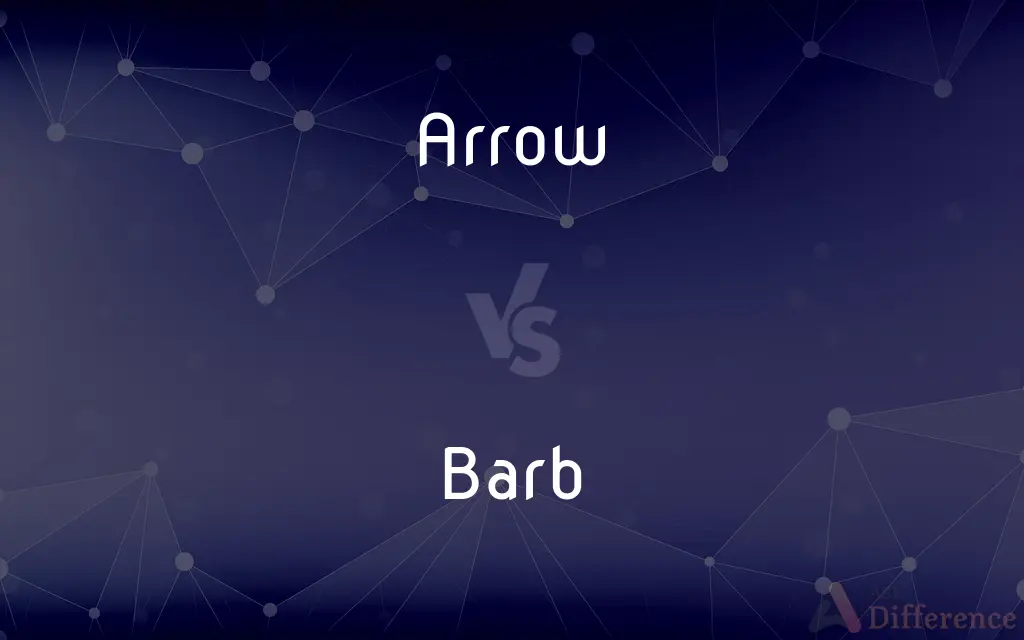Arrow vs. Barb — What's the Difference?
By Tayyaba Rehman & Urooj Arif — Updated on April 5, 2024
An arrow is a projectile used with bows, designed for precision and distance, whereas a barb is a sharp projection that prevents easy removal from an object.

Difference Between Arrow and Barb
Table of Contents
ADVERTISEMENT
Key Differences
Arrows are ancient weapons and tools, designed primarily for hunting and warfare, capable of striking targets from a considerable distance when launched from a bow. They are aerodynamically shaped to ensure flight stability and accuracy. On the other hand, barbs are small, sharp projections often found on objects like hooks, arrows, and plants. Their main purpose is to grip or hold onto something by making extraction difficult and painful, as in the case of a fish hook.
While arrows have evolved significantly over time, from simple wooden shafts with stone tips to modern carbon and aluminum designs with various head types for different purposes, barbs remain relatively unchanged in concept. They are simple yet effective in design, focusing on the principle of preventing a reverse movement. This makes barbs a critical feature in many tools and weapons, including some arrow types where they are used to ensure the arrow remains lodged in the target.
In terms of use, arrows are primarily associated with archery and hunting, requiring skill and practice to use effectively. They are part of a system that includes the bow, the archer, and the arrow itself. Conversely, barbs are used in a wider variety of contexts, not just as components of weapons but also in fishing, in the animal kingdom (such as on porcupines and stingrays), and in plants (like burdock), where they serve as a means of protection or dispersion.
Arrows, being tools of precision, are judged on their ability to hit and penetrate targets accurately. Factors such as the material, fletching, and tip design play significant roles in their effectiveness. Barbs, however, are judged more on their ability to adhere or catch onto surfaces or materials, making them invaluable in settings where retention is key, such as in fishing hooks and surgical instruments.
Despite their differences, arrows and barbs can be interconnected; for example, arrows used for hunting may feature barbed tips to ensure that once an animal is struck, the arrow remains embedded, making it easier for hunters to track and retrieve their game. This demonstrates how the concept of the barb has been ingenially incorporated into arrow design for specific purposes, blending the two elements’ distinct characteristics for enhanced effectiveness.
ADVERTISEMENT
Comparison Chart
Primary Use
Hunting and warfare
Gripping or holding by preventing withdrawal
Design Evolution
Evolved from simple wooden shafts to modern materials and aerodynamic shapes
Relatively unchanged, focuses on preventing reverse movement
Usage Context
Archery, hunting
Fishing, animal and plant defense mechanisms
Effectiveness Criteria
Accuracy, penetration
Adherence, catching capability
Interconnection
Can feature barbs for enhanced retention in hunting
Often standalone, but integral to some arrows
Compare with Definitions
Arrow
A shafted projectile that is shot with a bow.
He practiced shooting arrows at the archery range.
Barb
A sharp projection near the end of an arrow, hook, or similar object.
The fish hook's barb prevented it from being easily pulled out.
Arrow
A directed graph element.
The diagram showed arrows pointing from each task to its dependencies.
Barb
Part of a feather, branching from the shaft.
She used the barb of a feather in her artwork.
Arrow
A symbol or pointer used to indicate direction.
Follow the arrow on the sign to reach the exit.
Barb
A backward-facing point on a wire or fencing designed to deter passage.
The barbed wire was installed to secure the perimeter.
Arrow
A missile propelled by a device.
The ancient ballista fired large arrows over the walls of the fort.
Barb
A defensive feature on animals and plants.
The porcupine's quills are barbs that protect it from predators.
Arrow
A sign resembling an arrow, used to indicate force or movement.
The equation included a vector arrow above the variable.
Barb
A pointed comment or criticism.
Her barb about his cooking stung more than he cared to admit.
Arrow
An arrow is a fin-stabilized projectile launched by a bow. A typical arrow usually consists of a long, stiff, straight shaft with a weighty (and usually sharp and pointed) arrowhead attached to the front end, multiple fin-like stabilizers called fletchings mounted near the rear, and a slot at the rear end called nock for engaging the bowstring.
Barb
A sharp point projecting in reverse direction to the main point of a weapon or tool, as on an arrow or fishhook.
Arrow
A weapon consisting of a thin, straight stick with a sharp point, designed to be shot from a bow
I've never used a bow and arrow
The road continues straight as an arrow
Barb
A cutting remark.
Arrow
Move or appear to move swiftly and directly
Lights arrowed down into the airport
Barb
(Zoology) A small, sharp point projecting in reverse direction from the tip, as on a porcupine quill or a bee sting.
Arrow
A missile having a straight thin shaft and typically having a pointed head at one end and flight-stabilizing vanes at the tail end, meant to be shot from a bow.
Barb
(Zoology) One of the parallel filaments projecting from the main shaft of a feather.
Arrow
Something, such as a directional symbol, that is similar to an arrow in form or function.
Barb
(Botany) A short, sharp, reflexed bristle or hairlike projection.
Arrow
To move like an arrow.
Barb
See barbel1.
Arrow
To shoot with an arrow
Arrowed a deer.
Barb
Any of various Old World freshwater fishes of the genera Barbus, Puntius, and related genera of the family Cyprinidae.
Arrow
A projectile consisting of a shaft, a point and a tail with stabilizing fins that is shot from a bow.
Barb
A linen covering for a woman's head, throat, and chin worn in medieval times.
Arrow
A sign or symbol used to indicate a direction (e.g. →).
Barb
A horse of a breed introduced by the Moors into Spain from northern Africa that has high withers and an arched neck and is known for its speed and endurance.
Arrow
(graph theory) A directed edge.
Barb
Any of a breed of domestic pigeon that has prominent wattles around the eyes.
Arrow
A dart.
Barb
To provide or furnish with a barb.
Arrow
(computing) The -> symbol, which has specific meanings in various programming languages.
Barb
The point that stands backward in an arrow, fishhook, etc., to prevent it from being easily extracted. Hence: Anything which stands out with a sharp point obliquely or crosswise to something else.
Arrow
(botany) The inflorescence or tassel of a mature sugar cane plant.
Barb
(figuratively) A hurtful or disparaging remark.
To trade barbs
Arrow
(intransitive) To move swiftly and directly (like an arrow).
Barb
A beard, or that which resembles it, or grows in the place of it.
Arrow
(transitive) To let fly swiftly and directly.
Barb
(ornithology) One of the many side branches of a feather, which collectively constitute the vane.
Arrow
To develop an inflorescence.
Barb
(ichthyology) Any of various species of freshwater carp-like fish that have barbels and belong to the cyprinid family.
Arrow
To navigate using the arrow keys.
Arrow left until you reach the start of the text you want to delete.
Barb
(US) The sciaenid fish Menticirrhus americanus, found along the Atlantic and Gulf Coasts of the United States.
Arrow
A missile weapon of offense, slender, pointed, and usually feathered and barbed, to be shot from a bow.
Barb
(botany) A hair or bristle ending in a double hook.
Arrow
A mark to indicate a direction or relation
Barb
(obsolete) A muffler, worn by nuns and mourners.
Arrow
A projectile with a straight thin shaft and an arrowhead on one end and stabilizing vanes on the other; intended to be shot from a bow
Barb
Paps, or little projections, of the mucous membrane, which mark the opening of the submaxillary glands under the tongue in horses and cattle. The name is mostly applied when the barbs are inflamed and swollen.
Barb
(obsolete) A bit for a horse.
Barb
A plastic fastener, shaped roughly like a capital I (with serifs), used to attach socks etc. to their packaging.
Barb
The Barbary horse, a superior breed introduced from Barbary into Spain by the Moors.
Barb
A blackish or dun variety of pigeon, originally brought from Barbary.
Barb
A barbiturate.
Barb
Armor for a horse.
Barb
To furnish with barbs, or with that which will hold or hurt like barbs, as an arrow, fishhook, spear, etc.
Barb
To cut (hair).
Barb
(obsolete) To shave or dress the beard of.
Barb
(obsolete) To clip; to mow.
Barb
To cover a horse in armor.
Barb
Beard, or that which resembles it, or grows in the place of it.
The barbel, so called by reason of his barbs, or wattles in his mouth.
Barb
A muffler, worn by nuns and mourners.
Barb
Paps, or little projections, of the mucous membrane, which mark the opening of the submaxillary glands under the tongue in horses and cattle. The name is mostly applied when the barbs are inflamed and swollen.
Barb
The point that stands backward in an arrow, fishhook, etc., to prevent it from being easily extracted. Hence: Anything which stands out with a sharp point obliquely or crosswise to something else.
Barb
A bit for a horse.
Barb
One of the side branches of a feather, which collectively constitute the vane. See Feather.
Barb
A southern name for the kingfishes of the eastern and southeastern coasts of the United States; - also improperly called whiting.
Barb
A hair or bristle ending in a double hook.
Barb
The Barbary horse, a superior breed introduced from Barbary into Spain by the Moors.
Barb
A blackish or dun variety of the pigeon, originally brought from Barbary.
Barb
To shave or dress the beard of.
Barb
To clip; to mow.
Barb
To furnish with barbs, or with that which will hold or hurt like barbs, as an arrow, fishhook, spear, etc.
But rattling storm of arrows barbed with fire.
Barb
An aggressive remark directed at a person like a missile and intended to have a telling effect;
His parting shot was `drop dead'
She threw shafts of sarcasm
She takes a dig at me every chance she gets
Barb
The pointed part of barbed wire
Barb
A subsidiary point facing opposite from the main point that makes an arrowhead or spear hard to remove
Barb
One of the parallel filaments projecting from the main shaft of a feather
Barb
Provide with barbs;
Barbed wire
Barb
Provide with barbs;
Barbed wire
Common Curiosities
What is an arrow made of?
Arrows can be made from wood, carbon, aluminum, or a combination of materials for shafts, with various metals used for the tip.
Are all arrows equipped with barbs?
Not all arrows have barbs; some are designed with smooth tips for easy removal from targets, especially in competitive archery.
How does a barb work?
A barb works by digging into material or flesh and preventing easy withdrawal due to its angled shape.
What are the advantages of using barbed arrows in hunting?
Barbed arrows ensure that the arrow stays in the target, causing more damage and making the animal easier to track.
How do you remove a barbed arrow safely?
Removing a barbed arrow usually involves pushing it through or cutting around the barb to avoid causing further damage.
Can barbs be found in nature?
Yes, many animals and plants have barbs as a natural defense mechanism.
Can arrows be used without a bow?
While arrows are designed for use with bows, they can also be utilized in crossbows and other launching mechanisms.
How has arrow technology evolved?
Arrow technology has evolved from simple stone-tipped shafts to sophisticated designs using modern materials for better flight and impact.
Do barbs have uses outside of hunting and fishing?
Yes, barbs are used in security (barbed wire), medicine (surgical tools), and nature (animal defenses).
What's the difference between an arrowhead and a barb?
An arrowhead is the tip of an arrow designed for penetration, while a barb is a feature designed to prevent withdrawal.
What role do fletchings play in an arrow's flight?
Fletchings, usually made of feather or plastic, stabilize the arrow in flight, improving its accuracy.
Is it ethical to use barbed arrows in hunting?
The use of barbed arrows in hunting is subject to ethical debates, with considerations for animal welfare and hunting regulations.
How are arrows categorized?
Arrows can be categorized by their intended use (hunting, competition, recreation) and the materials they are made from.
What are the historical uses of arrows?
Historically, arrows have been used in warfare, hunting, and as tools in various cultures around the world.
Why are barbs used on fishing hooks?
Barbs on fishing hooks prevent the caught fish from slipping off the hook easily.
Share Your Discovery

Previous Comparison
Career vs. Passion
Next Comparison
Fajita vs. BurritoAuthor Spotlight
Written by
Tayyaba RehmanTayyaba Rehman is a distinguished writer, currently serving as a primary contributor to askdifference.com. As a researcher in semantics and etymology, Tayyaba's passion for the complexity of languages and their distinctions has found a perfect home on the platform. Tayyaba delves into the intricacies of language, distinguishing between commonly confused words and phrases, thereby providing clarity for readers worldwide.
Co-written by
Urooj ArifUrooj is a skilled content writer at Ask Difference, known for her exceptional ability to simplify complex topics into engaging and informative content. With a passion for research and a flair for clear, concise writing, she consistently delivers articles that resonate with our diverse audience.















































